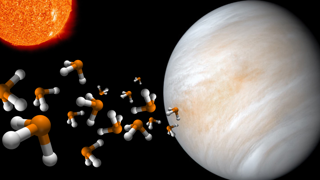
From Phosphine and Penguin Poo to Life on Venus?
- 8th Mar 2024
- Author: Jasneet Kaur
Life on Venus?
The extreme temperatures and toxic atmosphere are enough to persuade most humans that life on Venus is simply not possible. Well, not all were convinced…
In the thick clouds of Venus, Professor Jane Greaves found a special but very specific molecule named phosphine. On Earth, phosphine is found in penguin poo, landfill and it is produced by small bacteria that live in areas where there is no oxygen. So, does this mean discovery mean there is life on Venus?
Villainous Venus
Earth’s sizzling hot neighbour, Venus, is often referred to as Earth’s twin because of the similarities they share. They have a similar size, structure, gravity, and composition. But that's where the similarities end - Venus is more of the evil twin! In the picture shown the first thing you might notice is the difference in colour. Venus has an atmosphere made of carbon dioxide and sulphuric acid clouds that give the planet a slight yellow colour. The clouds act like a big curtain hiding away the surface of Venus, so scientists are still trying to find out more about the conditions and features on the planet.
Venus also holds the title for hottest planet in our Solar System with a fiery temperature of 464 degrees Celsius! This is caused by thick clouds that easily trap heat. So if you ever make a trip over to Venus, make sure to pack a strong sunscreen, some sunglasses, and a lot of ice cream (or maybe not)! Venus does not have any noticeable seasons and due to its tiny axial tilt towards the Sun, everyday is a scorching hot day. How could life possibly survive in Venus’ extreme conditions?
Did you know?
The ancient Romans looked up at the night sky and chose to name the planets after their most important gods. Venus is the only planet in our Solar System that is named after a female. In Roman mythology, Venus was the goddess of love and beauty.

The woman behind the discovery
Jane Greaves is a British astronomer at Cardiff University. Her research ranges from studying planets around younger stars to looking at Jupiter's icy moons for signs of life.
In 2020, Jane led a team of international astronomers and used the James Clerk Maxwell Telescope in Hawaii to detect phosphine roaming around the clouds of Venus.
She made this discovery on a late night in 2018, while she was alone in her office. She tried to contain her excitement and went to the shops to grab ingredients for a curry as a celebration.
After she and her team gathered more data and double-checked these findings, they announced the discovery in 2020.
-
![Phosphine in the Venusian atmosphere.]()
ESO/ M. Kornmesser/ L. Calçada/ NASA/ JPL-Caltech/ Royal Astronomical Society CC BY-SA 4.0 DEED All about Phosphine
Phosphine is a strange gas. Some describe the smell of phosphine as mouldy fish or garlic (Yuck!). On Earth, phosphine can show that there is life. Bacteria that live in funky places with low oxygen, eat a mineral called phosphate and mix it with hydrogen. They then let off phosphine gas and this can be detected. Why is finding this mysterious gas in the clouds of Venus a MAJOR discovery?
Jane’s theory is that microorganisms are hard at work in the atmosphere making their presence clear by emitting phosphine into Venus’ clouds. As a way of saying ‘’Hey guys! Here we are’’. Different microorganisms need different amounts of oxygen to survive and thrive. As the name suggests, these creatures are micro (small). We are unable to see them with our eyes. Don’t let their size fool you - these creatures are also very much alive.
-
![Microorganisms in a drop of seawater.]()
Jean-Baptiste Raina CC BY 4.0 DEED What does this discovery mean?
Venus does not have much oxygen and definitely does not have penguins. Does that mean this phosphine is coming from another life form? Maybe! Jane thinks high in the clouds of Venus, the conditions (where pressures and temperatures are more tolerable) may allow for microorganisms to form.
Around 50 kilometres from the surface of Venus the temperatures range from 30 to 70 degrees Celsius. These temperatures can support the development of life as they are closer to the temperatures we have on Earth.
Many scientists have considered different theories for how the phosphine may have formed on Venus. These range from volcanoes, sunlight or even lightning, but none of these factors could ever produce the levels of phosphine detected by Jane and her team.
-
![Artist's concept of the VERITAS mission proposed for NASA's Discovery program.]()
NASA/JPL-Caltech What’s next?
During the National Astronomy Meeting held in 2023, Jane revealed that further studies had shown phosphine was also found deeper in the atmosphere of Venus than previous measurements had shown. This raises more unanswered questions. Where is all this phosphine coming from? The only way we can answer these questions is by sending out a mission to Venus.
Two NASA missions, called VERITAS and DAVINCI, and Europe's EnVision orbiter are scheduled to launch in the upcoming years. DAVINCI will fly through Venus’ atmosphere and bring back samples that can be tested for the presence of microorganisms.
So to answer the question: Is there life on Venus? We cannot say for certain. Confirming the presence of life is only something we will be able to do once we have more information from a returned mission. What do you think? Will the answer be yes?
So what do you think - is phosphine a signature from some sort of life on Venus or is there some other explanation for the levels of phosphine found on our toxic neighbour!
Full references / credits:
(Banner image) A picture which shows the Sun (top left), Venus (right planet) and little
phosphine molecules floating around Venus. Credits: NASA/ Robert Lea
(1) A picture of Earth (left) and Venus (right).Credits: Earth: NASA; Venus: Magellan
Project/NASA/JPL
(2) Jane Greaves. Credit: Cardiff University / Jane Greaves.
(3a) Phosphine in the Venusian atmosphere. ESO/ M. Kornmesser/ L. Calçada/ NASA/ JPL-Caltech/ Royal Astronomical Society CC BY-SA 4.0 DEED https://commons.wikimedia.org/wiki/File:Venus-phosphine-atmosphere.jpg
(3b) Microorganisms in a drop of seawater. Jean-Baptiste Raina CC BY 4.0 DEED https://commons.wikimedia.org/wiki/File:Microorganisms_in_a_drop_of_seawater.jpg
(3c) Artist's concept of the VERITAS mission proposed for NASA's Discovery program. NASA/JPL-Caltech





